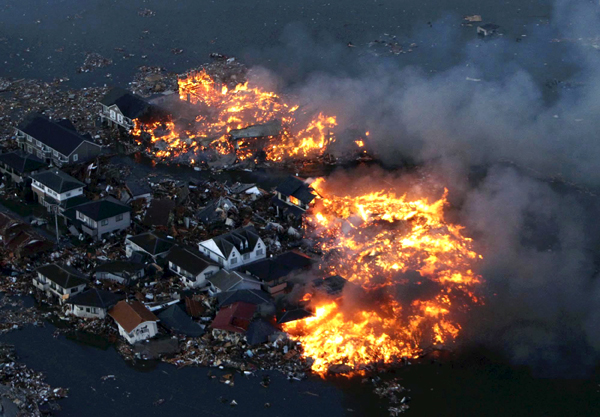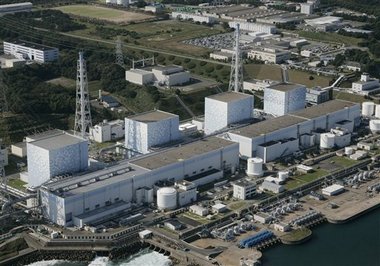First in a series on the systems dynamics of nuclear power in the light of the ongoing catastrophe at Fukushima.
Radioactive waste and melt downs are intrinsic properties of nuclear power. Before / After Gallery.
Current Assessment: 3/27/11 3:00 PM. 10,668 dead, 16,574 missing. Radiation levels spike, drop. (Gather). Silver lining in the cloud – radioactive substances will wind up in the Great Pacific Garbage Patch and trigger mutations in bacteria and plankton, creating “Plasticovores” – critters that chow down on plastic.
Eighth Assessment: 3/24/11 11:30 PM. 10,035 dead. 17,443 missing. Market Watch. Earlier in the day AP, Courtesy of the Star, Bloomberg. reported slightly lower numbers. We have seen a natural disaster of earthquake, tsunami, and aftershocks. While the the damage is tremendous, it could have been much worse. There are 10,035 tragedies, and 17,443 people are missing. It seems likely that many of them will never be found. Yet The nuclear plants have not yet undergone a full meltdown. This speaks volumes about American and Japanese engineering. The nuclear plants were built pretty well. Yet it also suggests that it is not prudent to build nuclear power plants in earthquake zones. Radioactive waste and meltdown are not intrinsic properties of solar, wind, geothermal, and conservation.
Seventh Assessment: 3/18/11 11:00 AM. The spin machines are beginning to sells this as a tragedy local to Japan. It won’t – can’t happen here. as something that requires tougher standards for future nuclear plant designs, as something that teaches us design lessons. ” ProPublica 1 and 2.
Sixth Assessment: 3/18/11 9:00 AM Death Toll: 6,911 (CNN). Shortages of food, water, medicines, heat, power. Yet some good news: Japanese soldiers and firefighters acting heroically and selflessly to try to prevent meltdown. There is no looting. The Japanese people are finding hope, trust, calm. The earthquake measured 9.0 on the Richter scale. The aftershocks: at least 27 of 6.0 or greater, at least 154 of 5.0 or greater.
Fifth Assessment: US: “Stay 50 miles (80.45 km) from the plant.” Sweden: “Stay 80 km (49.7 mi.) from the plant.” WSJ online. That is 20,096 square km or 7,850 square miles. Half of that is in the Pacific. Radiation damage: Significant.
Fourth Assessment: 3/16/11: 9:00 PM. We should decommission all nuclear reactors with all deliberate speed and replace them with a clean, renewable, sustainable energy topology!
Tertiary Assessment: 3/14/11: 9:00 PM. Explosions at three reactors. Cooling system failure, fuel rods heating out of control. Operators were pumping seawater into the plants in a desperate attempt to keep the fuel rods cool until the pumps failed. Meltdown occurring. Meltdown is a problem because of the laws of physics.
Second Assessment: The containment vessels and reactor cores said to remain intact after the explosions at Fukushima. Pumping in sea water is unprecedented. Radioactive material was released. How much radioactive material has been released? What is the material and what are the half-lives? Will the containment vessel remain sufficiently cool to avoid a meltdown? ”
Initial Assessment: (3/11/11) Meltdown Likely.
“Washington, 1972: If the cooling systems fail at a ‘Mark 1’ nuclear reactor, the primary containment vessel surrounding the reactor will probably burst as the fuel rods inside overheat. Dangerous radiation would spew into the environment.” Design Flaws of Mark 1 Nuclear Reactors – NYTimes.
Solar panels and wind turbines can be damaged in earthquakes and swept away in tsunamis. There is zero chance of long term collateral damage due to the very nature of solar modules and the laws of physics. ZERO! And if a solar array was swept away in a flood it could probably be used as a raft.
3/14/11. 9:00 PM EST. Explosions at three reactors
3/14/11. 9:00 AM EST. Death Count: 10,000 people. In addition 6 nuclear power stations are offline – some will be permanently. It is believed that there were partial meltdowns at 2, perhaps 3 of the 6 facilities in the Fukushima complex.
How many people lost on the four trains, including one bullet? How many cars per train? If 9 cars, with 30 passengers each, and 1 pilot, that’s 271 people per train, and 1084 people. The earthquake struck at 2:46 PM local time. If the trains were derailed by the earthquake there may have been many survivors. If the trains were swept out to sea by the Tsunami …
3/12/11. 10:30 PM EST. Partial Meltdown at Fukushima 1 and 3 here, here, and here. 120,000 people ordered to evacuate the area within 20 km of the plant! That’s a 20 km radius. Evacuation of 120,000 people withing 20 km / 12 mile of the plant. That’s 1,256 sq km. Or 452 square miles. New York City is an area of 321 square miles. Good thing there are no nuclear power plants near NYC. Wait – what about Indian Point?
Fukushima 3 uses a plutonium fuel. More dangerous.
Michio Kaku, at BigThink.com. “The fail-safe systems failed… battery power was left, about 8 hours worth, to keep water circulating over the core of the reactor. But after that was exhausted, temperatures began to rise, as well as pressures. (If the core of the reactor is ever exposed without water, temperatures can rise to 5,000 degrees F, at which uranium dioxide fuel beings to melt, initiating the China Syndrome. It takes 30 minutes to several hours for an exposed core to melt down. Then a steam explosion might have enough force to rupture the vessel and containment.) Attempts were made to ship 14 back-up generators. … with the pressure inside the reactor rising 50% above normal, attempts were made to vent some of this dangerous, excess pressure. Radiation levels soared to 1,000 times normal levels inside the containment building.“
3/12/11. 4:45 PM EST. Nuclear Information and Resource Service, NIRS.org Fact Sheet on Fukushima.
3/12/11. 9:00 AM EST.
USA Today: ” Japan government spokesman Yukio Edano said ‘the explosion destroyed the exterior walls of the building where the reactor is placed, but not the actual metal housing enveloping the reactor… The radiation around the Fukushima Dai-ichi plant had not risen after the blast, but had in fact decreased. … The pressure in the reactor was also decreasing after the blast.’ ”
My questions: If the radiation decreased after the blast, is it because the radioactive material was dispersed in the blast? What else would account for a decrease in radiation? Radioactivity doesn’t get “absorbed” in a blast.
USA Today: “The explosion was preceded by puff of white smoke that gathered intensity until it became a huge cloud enveloping the entire facility, located in Fukushima, 20 miles from Iwaki. After the explosion, the walls of the building crumbled, leaving only a skeletal metal frame.” 51,000 people evacuated from what is now a 12 mile radius around the plant.”

after tsunami
3/12/11. 5:00 AM EST.: Dave Batty, Guardian, UK, “One of the buildings of Fukushima nuclear power complex reported to have been destroyed in an explosion.”
Matt Wald, NY Times Evacuation of 45,000 people in 6-mile radius around Daiichi and 1-mile radius around Diani nuclear power stations. No radiation reported around Diani. Release of radiation from Daiichi.
Martin Fackler, NY Times. “Death toll … in the hundreds… could rise to more than 1,300, most of them drowned. … Thousands of homes … destroyed … roads … impassable, trains and buses … not running, and power and cellphones … down. … three trains missing …” Economic Times, India, “Death toll now at 1,600…. Four trains missing.”
This is the death toll from the tsunami. How many people were on the trains? How are trains “missing?” These are like NJ Transit, NYC Subway, MetroNorth, Amtrack. Did they get swept away in the 22 foot waves of the Tsunami?
Some good news: “While the loss of life and property may yet be considerable, many lives were certainly saved by Japan’s extensive disaster preparedness and strict construction codes.” Fackler, NY Times.
3/11/11. 10:00 PM EST. News of quake: (US Geological Survey)
Photos – NY Times.
3/11/11. 8:00 PM EST. When an earthquake or tusnami knock out some solar arrays or wind turbines food might spoil because a refrigerator loses power. But if an earthquake or tsunami knocks out the cooling system of a nuclear power plant – which is what happened at the Japanese plants – thousands of people need to be evacuated due to the risk of a meltdown (click here or here). Note that San Clemente, San Onofre, Diablo Canyon are on the Pacific, Salem, Hope Creek, Oyster Creek, are on the Atlantic. Indian Point is on the Hudson, not too far from New York City and New York Harbor.
The AP reported: “Japan quake causes emergencies at 5 nuke reactors
“Japan declared states of emergency for five nuclear reactors at two power plants after the units lost cooling ability in the aftermath of Friday’s powerful earthquake. Thousands of residents were evacuated as workers struggled to get the reactors under control to prevent meltdowns.
“Operators at the Fukushima Daiichi plant’s Unit 1 scrambled ferociously to tamp down heat and pressure inside the reactor after the 8.9 magnitude quake and the tsunami that followed cut off electricity to the site and disabled emergency generators, knocking out the main cooling system.
“Evacuation zone … 10 kilometers after authorities reported eight times the normal radiation levels outside the facility and 1,000 times normal inside Unit 1’s control room.
“Tokyo Electric Power Co., which operates the six-reactor Daiichi site in northeastern Japan, announced that it had lost cooling ability at a second reactor there and three units at its nearby Fukushima Daini site. … Nearly 14,000 people living near the two power plants were ordered to evacuate.
“Japan’s nuclear safety agency said the situation was most dire at Fukushima Daiichi’s Unit 1, where pressure had risen to twice what is consider the normal level. The International Atomic Energy Agency said in a statement that diesel generators that normally would have kept cooling systems running at Fukushima Daiichi had been disabled by tsunami flooding. … Officials at the Daiichi facility began venting radioactive vapors from the unit to relieve pressure inside the reactor case. The loss of electricity had delayed that effort for several hours.”
My assessment: Meltdown Likely.
First in a series on the economics, ecological economics, finance, logistics, and systems dynamics of nuclear power in the light of the ongoing catastrophe at Fukushima.
- Earthquake, Tsunami and Energy Policy, March 11-13, 2011. Here.
- After Fukushima, Wall Street Bearish on Nuclear Power. March 14, 2011. Here.
- Fukushima: Worse than Chernobyl? Here.
- Fukushima: GE Mark 1: Unsustainable by Design. Here
- Is Fukushima Dai-icha worse than Chernobyl? Here.
- Nuclear Power: What Future? Here.
